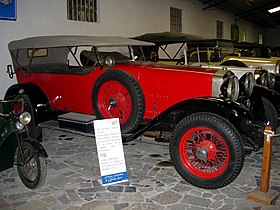Alfa Romeo RL
| Alfa Romeo RL | |
|---|---|

Alfa Romeo RLSS (1925) with Lucas body from Barcelona
|
|
| Overview | |
| Manufacturer | Alfa Romeo |
| Production | 1922–1927 |
| Assembly | Portello, Milan, Italy |
| Designer | Giuseppe Merosi |
| Body and chassis | |
| Layout | Front-engine, rear-wheel drive |
| Related | Alfa Romeo RM |
| Powertrain | |
| Engine |
|
| Transmission | 4-speed manual |
| Dimensions | |
| Wheelbase |
|
| Length | 4,630 mm (182.3 in) Zagato 4,450 mm (175.2 in) Castagna |
| Width | 1,770 mm (69.7 in) Zagato 1,870 mm (73.6 in) Castagna |
| Height | 1,650 mm (65.0 in) Zagato 1,630 mm (64.2 in) Castagna |
| Kerb weight | 1,550 kg (3,417 lb) Zagato 1,600 kg (3,527 lb) Castagna |
| Chronology | |
| Predecessor | Alfa Romeo G1 |
| Successor | Alfa Romeo 6C 1500 |
The Alfa Romeo RL was produced between 1922-1927. It was Alfa's first sport model after World War I. The car was designed in 1921 by Giuseppe Merosi. It had a straight-6 engine with overhead valves. Three different versions were made: Normale, Turismo and Sport. RL total production was 2640. The RLTF (Targa Florio) was the race version of RL - it weighed half of normal versions, the engine had seven main bearings instead of four and double carburetors. In 1923 Alfa's race team had drivers like Ugo Sivocci, Antonio Ascari, Giulio Masetti and Enzo Ferrari. Sivocci's car had green cloverleaf symbol on white background and when he won Targa Florio 1923, that symbol was to become the Alfa team's good luck token.
In 1927, 2 different RLSS were entered in the first Mille Miglia, but both dropped out after briefly leading the race. A 1925 RLSS version with rare, original bodywork by Thornton Engineering Company in Bradford, UK, is on permanent display in the Brooklands exhibit at the Simeone Foundation Automotive Museum in Philadelphia, PA, USA. It is one of only 9 RLSS still in existence.
Variants:
Alfa Romeo RL Targa Florio 1923
Alfa Romeo RL Targa Florio 1924
Short video clip of 1924 RL Targa Florio
Alfa Romeo RL Super Sport with Castagna brushed aluminium body
...
Wikipedia
